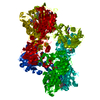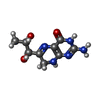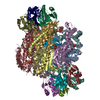+ Open data
Open data
- Basic information
Basic information
| Entry | Database: PDB / ID: 6z85 | ||||||
|---|---|---|---|---|---|---|---|
| Title | inhibitory human GTP cyclohydrolase I - GFRP complex | ||||||
 Components Components |
| ||||||
 Keywords Keywords | HYDROLASE / GTP cyclohydrolase GFTP / I / EC:3.5.4.16 / Tetrahydrobiopterin (BH4) synthesis / Cytosol / Zinc Ion Binding / Hydrolase Activity / Metal Ion Binding / Nucleotide Binding / allosteric inhibited | ||||||
| Function / homology |  Function and homology information Function and homology informationGTP cyclohydrolase binding / pteridine-containing compound biosynthetic process / dihydrobiopterin metabolic process / regulation of lung blood pressure / GTP cyclohydrolase I / GTP cyclohydrolase I activity / neuromuscular process controlling posture / negative regulation of biosynthetic process / GTP-dependent protein binding / regulation of removal of superoxide radicals ...GTP cyclohydrolase binding / pteridine-containing compound biosynthetic process / dihydrobiopterin metabolic process / regulation of lung blood pressure / GTP cyclohydrolase I / GTP cyclohydrolase I activity / neuromuscular process controlling posture / negative regulation of biosynthetic process / GTP-dependent protein binding / regulation of removal of superoxide radicals / tetrahydrobiopterin biosynthetic process / neuron projection terminus / regulation of nitric oxide biosynthetic process / mitogen-activated protein kinase binding / dopamine biosynthetic process / negative regulation of cardiac muscle cell apoptotic process / positive regulation of heart rate / response to pain / response to type II interferon / negative regulation of cellular senescence / response to tumor necrosis factor / Tetrahydrobiopterin (BH4) synthesis, recycling, salvage and regulation / tetrahydrofolate biosynthetic process / positive regulation of telomere maintenance via telomerase / nitric oxide biosynthetic process / negative regulation of blood pressure / positive regulation of nitric-oxide synthase activity / regulation of blood pressure / vasodilation / positive regulation of neuron apoptotic process / melanosome / nuclear membrane / cytoplasmic vesicle / protein-containing complex assembly / response to lipopolysaccharide / GTPase activity / dendrite / calcium ion binding / protein-containing complex binding / GTP binding / protein homodimerization activity / protein-containing complex / mitochondrion / zinc ion binding / nucleoplasm / identical protein binding / nucleus / cytoplasm / cytosol Similarity search - Function | ||||||
| Biological species |  Homo sapiens (human) Homo sapiens (human) | ||||||
| Method | ELECTRON MICROSCOPY / single particle reconstruction / cryo EM / Resolution: 2.9 Å | ||||||
 Authors Authors | Ebenhoch, R. / Nar, H. / Vonck, J. | ||||||
 Citation Citation |  Journal: Proc Natl Acad Sci U S A / Year: 2020 Journal: Proc Natl Acad Sci U S A / Year: 2020Title: A hybrid approach reveals the allosteric regulation of GTP cyclohydrolase I. Authors: Rebecca Ebenhoch / Simone Prinz / Susann Kaltwasser / Deryck J Mills / Robert Meinecke / Martin Rübbelke / Dirk Reinert / Margit Bauer / Lisa Weixler / Markus Zeeb / Janet Vonck / Herbert Nar /  Abstract: Guanosine triphosphate (GTP) cyclohydrolase I (GCH1) catalyzes the conversion of GTP to dihydroneopterin triphosphate (H2NTP), the initiating step in the biosynthesis of tetrahydrobiopterin (BH4). ...Guanosine triphosphate (GTP) cyclohydrolase I (GCH1) catalyzes the conversion of GTP to dihydroneopterin triphosphate (H2NTP), the initiating step in the biosynthesis of tetrahydrobiopterin (BH4). Besides other roles, BH4 functions as cofactor in neurotransmitter biosynthesis. The BH4 biosynthetic pathway and GCH1 have been identified as promising targets to treat pain disorders in patients. The function of mammalian GCH1s is regulated by a metabolic sensing mechanism involving a regulator protein, GCH1 feedback regulatory protein (GFRP). GFRP binds to GCH1 to form inhibited or activated complexes dependent on availability of cofactor ligands, BH4 and phenylalanine, respectively. We determined high-resolution structures of human GCH1-GFRP complexes by cryoelectron microscopy (cryo-EM). Cryo-EM revealed structural flexibility of specific and relevant surface lining loops, which previously was not detected by X-ray crystallography due to crystal packing effects. Further, we studied allosteric regulation of isolated GCH1 by X-ray crystallography. Using the combined structural information, we are able to obtain a comprehensive picture of the mechanism of allosteric regulation. Local rearrangements in the allosteric pocket upon BH4 binding result in drastic changes in the quaternary structure of the enzyme, leading to a more compact, tense form of the inhibited protein, and translocate to the active site, leading to an open, more flexible structure of its surroundings. Inhibition of the enzymatic activity is not a result of hindrance of substrate binding, but rather a consequence of accelerated substrate binding kinetics as shown by saturation transfer difference NMR (STD-NMR) and site-directed mutagenesis. We propose a dissociation rate controlled mechanism of allosteric, noncompetitive inhibition. | ||||||
| History |
|
- Structure visualization
Structure visualization
| Movie |
 Movie viewer Movie viewer |
|---|---|
| Structure viewer | Molecule:  Molmil Molmil Jmol/JSmol Jmol/JSmol |
- Downloads & links
Downloads & links
- Download
Download
| PDBx/mmCIF format |  6z85.cif.gz 6z85.cif.gz | 562.8 KB | Display |  PDBx/mmCIF format PDBx/mmCIF format |
|---|---|---|---|---|
| PDB format |  pdb6z85.ent.gz pdb6z85.ent.gz | 414.2 KB | Display |  PDB format PDB format |
| PDBx/mmJSON format |  6z85.json.gz 6z85.json.gz | Tree view |  PDBx/mmJSON format PDBx/mmJSON format | |
| Others |  Other downloads Other downloads |
-Validation report
| Summary document |  6z85_validation.pdf.gz 6z85_validation.pdf.gz | 1.3 MB | Display |  wwPDB validaton report wwPDB validaton report |
|---|---|---|---|---|
| Full document |  6z85_full_validation.pdf.gz 6z85_full_validation.pdf.gz | 1.3 MB | Display | |
| Data in XML |  6z85_validation.xml.gz 6z85_validation.xml.gz | 61 KB | Display | |
| Data in CIF |  6z85_validation.cif.gz 6z85_validation.cif.gz | 81.7 KB | Display | |
| Arichive directory |  https://data.pdbj.org/pub/pdb/validation_reports/z8/6z85 https://data.pdbj.org/pub/pdb/validation_reports/z8/6z85 ftp://data.pdbj.org/pub/pdb/validation_reports/z8/6z85 ftp://data.pdbj.org/pub/pdb/validation_reports/z8/6z85 | HTTPS FTP |
-Related structure data
| Related structure data |  11114MC  6z80C  6z86C  6z87C  6z88C  6z89C  7accC  7al9C  7alaC  7albC  7alcC M: map data used to model this data C: citing same article ( |
|---|---|
| Similar structure data |
- Links
Links
- Assembly
Assembly
| Deposited unit | 
|
|---|---|
| 1 |
|
- Components
Components
| #1: Protein | Mass: 25324.920 Da / Num. of mol.: 10 Source method: isolated from a genetically manipulated source Source: (gene. exp.)  Homo sapiens (human) / Gene: GCH1, DYT5, GCH / Production host: Homo sapiens (human) / Gene: GCH1, DYT5, GCH / Production host:  #2: Protein | Mass: 9992.483 Da / Num. of mol.: 10 Source method: isolated from a genetically manipulated source Source: (gene. exp.)  Homo sapiens (human) / Gene: GCHFR, GFRP / Production host: Homo sapiens (human) / Gene: GCHFR, GFRP / Production host:  #3: Chemical | ChemComp-ZN / #4: Chemical | ChemComp-HBI / Has ligand of interest | Y | |
|---|
-Experimental details
-Experiment
| Experiment | Method: ELECTRON MICROSCOPY |
|---|---|
| EM experiment | Aggregation state: PARTICLE / 3D reconstruction method: single particle reconstruction |
- Sample preparation
Sample preparation
| Component | Name: inhibitory GCH1-GFRP complex (BH4 bound) / Type: COMPLEX / Entity ID: #1-#2 / Source: MULTIPLE SOURCES | |||||||||||||||
|---|---|---|---|---|---|---|---|---|---|---|---|---|---|---|---|---|
| Molecular weight | Value: 0.353 MDa / Experimental value: NO | |||||||||||||||
| Source (natural) | Organism:  Homo sapiens (human) Homo sapiens (human) | |||||||||||||||
| Source (recombinant) | Organism:  | |||||||||||||||
| Buffer solution | pH: 5.75 | |||||||||||||||
| Buffer component |
| |||||||||||||||
| Specimen | Conc.: 0.25 mg/ml / Embedding applied: NO / Shadowing applied: NO / Staining applied: NO / Vitrification applied: YES | |||||||||||||||
| Specimen support | Grid material: COPPER / Grid mesh size: 400 divisions/in. / Grid type: C-flat-1.2/1.3 | |||||||||||||||
| Vitrification | Instrument: FEI VITROBOT MARK IV / Cryogen name: ETHANE / Humidity: 90 % / Chamber temperature: 277.15 K |
- Electron microscopy imaging
Electron microscopy imaging
| Experimental equipment |  Model: Titan Krios / Image courtesy: FEI Company |
|---|---|
| Microscopy | Model: FEI TITAN KRIOS |
| Electron gun | Electron source:  FIELD EMISSION GUN / Accelerating voltage: 300 kV / Illumination mode: FLOOD BEAM FIELD EMISSION GUN / Accelerating voltage: 300 kV / Illumination mode: FLOOD BEAM |
| Electron lens | Mode: BRIGHT FIELD / Nominal magnification: 130000 X / Nominal defocus max: 2400 nm / Nominal defocus min: 1000 nm / Cs: 2.7 mm |
| Specimen holder | Cryogen: NITROGEN / Specimen holder model: FEI TITAN KRIOS AUTOGRID HOLDER |
| Image recording | Average exposure time: 8 sec. / Electron dose: 55 e/Å2 / Detector mode: COUNTING / Film or detector model: GATAN K2 SUMMIT (4k x 4k) / Num. of grids imaged: 1 / Num. of real images: 2688 |
| EM imaging optics | Energyfilter name: GIF Bioquantum / Energyfilter slit width: 20 eV |
| Image scans | Movie frames/image: 40 |
- Processing
Processing
| Software | Name: PHENIX / Version: (1.13_2998:phenix.real_space_refine) / Classification: refinement | ||||||||||||||||||||||||||||||||||||||||
|---|---|---|---|---|---|---|---|---|---|---|---|---|---|---|---|---|---|---|---|---|---|---|---|---|---|---|---|---|---|---|---|---|---|---|---|---|---|---|---|---|---|
| EM software |
| ||||||||||||||||||||||||||||||||||||||||
| CTF correction | Type: PHASE FLIPPING AND AMPLITUDE CORRECTION | ||||||||||||||||||||||||||||||||||||||||
| Particle selection | Num. of particles selected: 1871460 | ||||||||||||||||||||||||||||||||||||||||
| Symmetry | Point symmetry: D5 (2x5 fold dihedral) | ||||||||||||||||||||||||||||||||||||||||
| 3D reconstruction | Resolution: 2.9 Å / Resolution method: FSC 0.143 CUT-OFF / Num. of particles: 560802 / Symmetry type: POINT | ||||||||||||||||||||||||||||||||||||||||
| Atomic model building | Protocol: RIGID BODY FIT | ||||||||||||||||||||||||||||||||||||||||
| Atomic model building |
| ||||||||||||||||||||||||||||||||||||||||
| Refinement | Cross valid method: THROUGHOUT | ||||||||||||||||||||||||||||||||||||||||
| Displacement parameters | Biso max: 0 Å2 / Biso mean: 0 Å2 / Biso min: 0 Å2 | ||||||||||||||||||||||||||||||||||||||||
| Refine LS restraints |
|
 Movie
Movie Controller
Controller









 PDBj
PDBj












